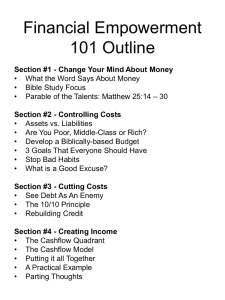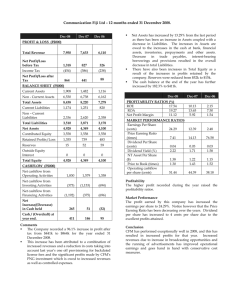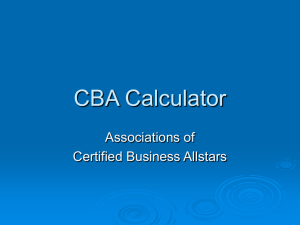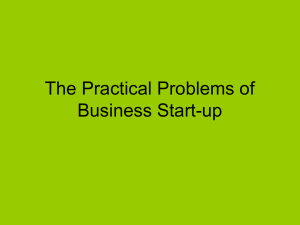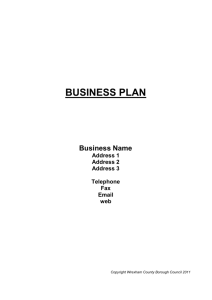Project-Based Learning in Engineering Economics: Stock Price Model
advertisement
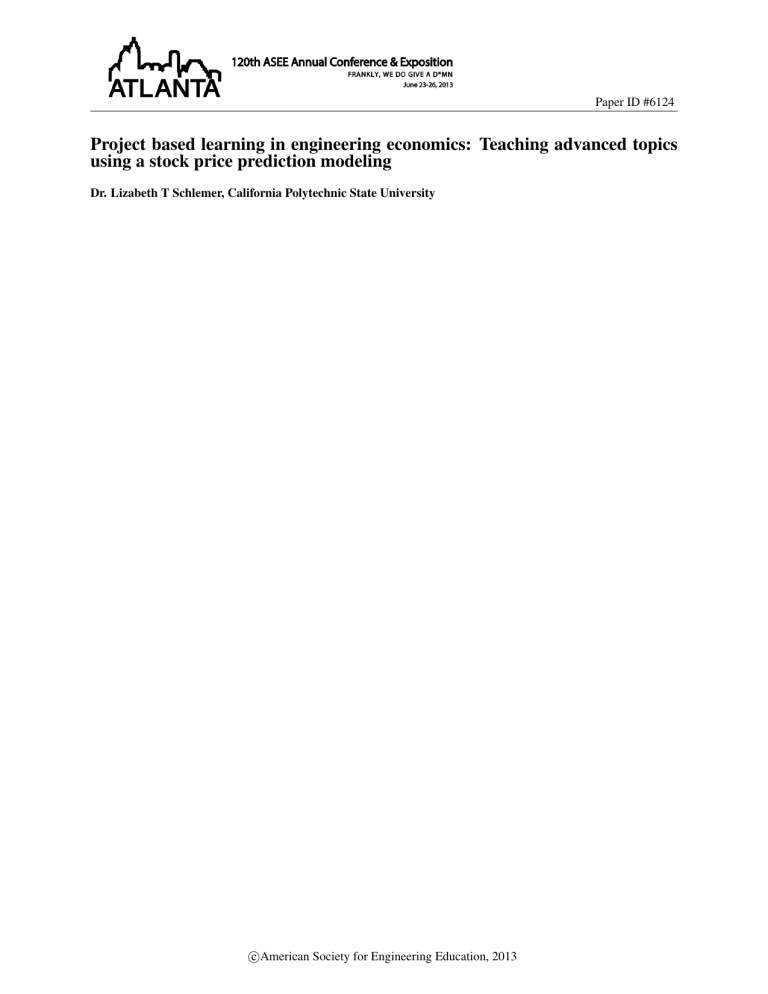
Paper ID #6124 Project based learning in engineering economics: Teaching advanced topics using a stock price prediction modeling Dr. Lizabeth T Schlemer, California Polytechnic State University c American Society for Engineering Education, 2013 Project based learning in engineering economics: Teaching advanced topics using a stock price prediction model Abstract: A graduate level advanced engineering economics class taught at California Polytechnic State University, San Luis Obispo, includes a thorough review of time value of money, investment evaluation, inflation, risk and return, financing decisions, corporate investment strategies, risk analysis and decisions incorporating non-monetary considerations. Historically this course was taught using an advanced text where the topics were covered sequentially. A redesign of the course now includes the construction of a stock price prediction model for a company of the student’s choice. Through the model, the topics are covered and discussed in the context of the large model-building project. For instance, inflation is discussed when students collect historic data on the company’s performance and use that data to forecast into the future. Issues of discount rate and variability in inflation become evident as students wrestle with the past and the future. The concepts of risk, return and the capital asset pricing model are introduced as students begin to understand how the required return for equity holders is not only dependent on the underlying risk of the assets, but on the leverage of the firm. Given varying levels of debt, the relative stability of the required return on the assets (as opposed to the equity) emerges as a better analysis tool. This paper will discuss this project-based method in detail and give examples of instructional pedagogy that includes “Project Based Learning,” “Pull instruction,” and the use of a “Flipped Classroom.” In addition, student feedback on the topic is included. Introduction Project or Problem Based Learning (PBL) is a preferred teaching method in many situations. Generally this pedagogy enhances innovation (Lehmann, et al 2008), metacognition (Downing et al, 2008), meaningfulness and thus engagement (Stobral, 1995, Smith et al, 2005, Jiusto & DiBaiasio, 2006), promotes an integrated curriculum (Froyd & Ohland, 2005, Coyle et al, 2006), encourages design thinking (Dym et al, 2005), and is creative and interesting for the instructor. The PBL pedagogy uses an open-ended ambiguous problem or project to provide context for student’s inductive reasoning. In project based learning the project is usually larger than in problem based learning, spanning a week or more in instructional time. Often a large project, if correctly selected, can also match with a “pull” method of education where the project dictates the topics learned. The project described in this paper is large enough to encompass the entire quarter and complex enough to cover the majority of topics usually covered in this graduate level advanced engineering economy course. In the past this course was taught with an advanced text (Canada, et al, 2005) and topics were presented sequentially. The redesign incorporates the interrelatedness of the topics into a project. The students work the entire quarter to build an excel based model to predict the stock price of a firm. The integration of topics is illustrated in Figure 1. The topics are contained in the ovals and the activities performed by the students are contained in the arrows. This project starts during week two of the ten-week quarter and is completed by week nine. The project culminates in a presentation of the model by the student to the entire class. The model is built individually, but since the methodology for each model is similar, much collaboration takes place. The graduate students in our department are all familiar with each other as they take many courses together enhancing their ability to work together. Although team projects have a place in our curriculum, since this is a excel model, learning is maximized when done individually. Figure 1: Topics incorporated into the project The basis for this stock price model was developed when I worked for Unocal Corporation in the 1980’s. It is based on theories developed in finance and engineering economy that are similar to the “discounted cashflow” method of stock evaluation (Rahgozar, 2008, Becchetti et all, 2004, Rawley et al 2006). When at Unocal, my colleagues and I in the strategic planning department built a model to forecast the stock price of Unocal during the take over fight with T. Boone Pickens (McCoy, 1985). We used the model to predict the change in the stock price as information was relayed to the investment community. It was very accurate and was extremely helpful in the take over defense. The point of this project, as it was in the case of Unocal’s stock price model, is not to develop a model that will calculate some particular “right” value, but to develop a model that is useful for both understanding how the market views a company and to perform what-if analysis to determine the effect of company strategies or economic news on the stock price. For instance the model we built in the late 1980’s allowed us to calculate the effect that a “poison pill” take-over defense (Cody, 2011) would have on Unocal’s stock price. This same model was used to determine the change in the stock price with various methods of refinancing the large debt incurred after the defense. For the students developing the model it can give them insight into the company. These insights can be useful as students make career decisions. Advanced engineering economy addresses many of the topics covered in the tradition finance class in business school, but also discusses methods of project evaluation. The fundamentals of time value of money and project evaluation were taught in the undergraduate course. The advanced course attempts to illustrate the process of investment in engineering projects as it fits into the company as a whole and how that investment strategy can have an influence on the overall performance of a firm as reflected in the stock price. One of the features in the model that helps students understand the relationship between project investment strategy and company stock price performance is in an “investment strategy” subroutine where the amount of capital invested and project returns can influence the stock price. Instructional pedagogies This course utilizes several instructional strategies beyond PBL. Generally content is delivered in a “Flipped classroom,” format (Waldorf & Schlemer, 2012). The sequence of content delivery is dictated by the needs in the project, not by the organization of the text book. This method is often referred to as “Pull Education,” as opposed to a “Push” method. (Arif, Smiley, & Kulonda, 2005). In addition, attention is paid to motivation of the students by incorporating knowledge of intrinsic motivation: Autonomy, Mastery and Meaning (Deci & Ryan, 1987). The use of mastery also results in a non-traditional grading method. Using a flipped classroom, or what we sometimes refer to as “inside-out” (Waldorf & Schlemer, 2012), students are required to watch videos before class so that class time can be spent on application of the content to the stock price model. Sometimes the videos are ones that are prepared by the instructor and other times the videos are from an open source location such as Khan Academy (www.khanacademy.org). Several times students asked for clarification on topics, which then resulted in a short in-class lecture. Other times an overview of the content is necessary so that students don’t loose track of the integration of topics. Because in class time is unstructured, this method requires that the faculty have deep subject knowledge and is able to think quickly regarding student questions and misconceptions. A “Pull” instructional technique requires that the faculty member pay very close attention to the needs of the students and deliver content just-in-time. Of course every student comes in with varying levels of preparation. Some students in our program have undergraduate degrees in nonIE engineering majors and thus have had only limited exposure to engineering economy, while others are IE undergraduates and may have also taken a business finance course. Given the differing needs of the students, effort is made to give access to remedial instructional information. Several videos are available to bring everyone up to speed on the intricacies of Net Preset Value (NPV) or the various methods of project evaluation. Intrinsic motivation in instruction is very important to me. Forcing students to do work in my class is not something I am interested in. I believe students will want to learn if the structure is such that they can choose what to learn, develop mastery of the subject, and understand the meaning or purpose in what they do (Deci & Ryan, 1987). It is also my belief that without intrinsic motivation learning is shallow (understanding as defined by the instructor), and short lived (resulting in students desire to learn only what will be on the test). In this course autonomy is used by allowing students to choose the company they wanted to explore. I urged them to choose a company that they might want to work for. In this way the meaning or usefulness of their learning is clear. In order to promote mastery, the grading system is aligned with principles that include clear feedback and the ability of the student to resubmit incomplete or incorrect work. This results in students feeling as if they have control over the grade in the course. Practically this meant their course grade is based only on the quality of their final model. This includes 5 or 6 graded feedback opportunities on the model throughout the quarter. These grades are only there to guide the student, not to evaluate. I believe the use of these innovative pedagogies complement the project based learning mode of delivery of this engineering economy course. Model description Below is a detailed description of the model used in the course. Also included are examples from the student developed models. Throughout the description are suggestions for instructional opportunities. We begin the course with a discussion of the basic theories of stock price including rational markets, trading of stocks, and investment banking. What becomes clear in this conversation is that the internal strategies of a firm cannot change the stock price unless the markets know and believe the profit potential regarding these strategies. This gives us an opportunity to discuss rational markets theory (Brealey, et al. 2007). In addition, students have questions about insider trading and employee stock ownership. This discussion relates directly to their own future decisions as employees and investors, which reinforce the intrinsic meaning of the project. Choice of companies In order to support autonomous learning opportunities (Deci & Ryan, 1987) the choice of the company to analyze belongs to the student. The company must be publically traded, it must have a sufficient amount of historical data, and it should be of interest to the student. I urge them to choose a company that they are considering for career, one where they have worked for the summer, or possible the firm where one of their parent’s work. Since the historic data will be used to forecast into the future, the more data points available the better, but in practice ten data point (ten years) is about the most that they can collect without distortions. The data should be available by division or geographic area. The more detailed the numbers, the more accurate the forecast. The basics of the model Theoretically the stock price is equal to the equity divided by the number of shares outstanding. Using the equity of a firm as reported in the balance sheet in the 10K usually does not yield the stock price. The reasons for the difference between reported equity per share and stock price are many, but the theory used in this model is that the difference is due to a miss-valuation of the assets. The booked (as reported in the balance sheet) assets have many distortions: The assets may have been purchased long ago so the inflationary effects will distort values; the firm has developed a method of using the assets to create value so that the purchase price of the assets are much less than the cashflow from these assets (good investments and high return); or the firm may have “assets” that are not appearing on the balance sheet (star employees, an excellent research and development enterprise, large market share, or other barriers to entry). If we assume an efficient market (Brealey, et al. 2007) all these things will be taken into account by the market in the stock price. The market is implicitly forecasting into the future the profitability of the enterprise. The investment bankers are using historical performance and qualitative knowledge about the company to capture the market value. We also can use historic performance of the assets and project that performance into the future. From these projections, a present value of the assets can be calculated. If we subtract from the present value, the long-term liabilities of the firm we can get a good estimate of the market capitalization. Dividing that number by the number of shares gives an estimated stock price (see Equations 1 through 4 below). Equation 1: Stock price calculation 𝑠= ! !!! 𝐶!" −𝐿 (1 + 𝑖)! 𝑁 Equation 2: Cashflow from assets is equal to earning plus interest expense CA=CL+CE Equation 3: General account equation A=L+E Equation 4: Relationship between cashflow, value, and return 𝑖 ! = !! ! , 𝑛 = ∞ (also true for E and L subscripts) s :Stock Price ($/shr) N: number of shares n: life (years) A: Total Assets ($) L: Long Term Liabilities ($) E Total Equity ($) iA: required return on assets, MARR, Discount rate (%/yr) iL: required return on liabilities, interest rate on debt (%/yr) iE: required return on equity (%/yr) CA: Cashflow from Assets ($/yr) CL: Cashflow from liabilities, Interest payment per year ($/yr) CE: Cashflow for equity, earnings per year ($/yr) The reason we estimate the value of the assets and subtract the liabilities instead of directly forecasting the earnings to calculate the present value of the equity, is that given the CAPM model (Brealey, et al. 2007) the required return to equity holders is very much dependent on the financing (leverage) of the firm. If there is more debt, the equity of the firm is more risky, thus requiring a higher return. In contrast, the return on assets is more stable and only dependent on the riskiness of the assets. In order to develop the discounted cashflow independent of changes in financing, the cashflow from the assets must be determined. The diagram in Figure 2 below shows how value, cashflow and return are related. I use the following diagram in class and on videos to illustrate these basic relationships. Figure 2: Relationship between cashflow, value and returns The relationship between the return, cashflow and value is related to the concept of “capitalized costs” when a cashflow continues to infinity (equation 4). Collect cashflow from annual reports Annual 10K reports are the source of historic information. Since cashflow from assets is not a value reported, students will calculate this value by adding earnings to the interest (Equation 2 above). These values are always available in the report for the consolidated company, but in order to perform a detailed forecast it is best for each division’s cashflow to be collected. All companies report some kind of division in their earnings or revenues. Figure 3 has the details that are available for Nike from their 10K. Nike does not report earnings by division, but does report revenues. This distribution of revenue is used as a proxy for the distribution of earnings. Of course this assumes that expenses are proportionate across divisions. This may not be true, but lacking any other information this is the assumption we use. Interest should also be distributed in this same way. The sum of earnings and interest is the cashflow from assets for each division. This data should be collected for at least ten years of history. Sometimes companies change the method of reporting divisions. Sometimes divisions are created or dropped. Students must carefully read the annual report to determine the best way to handle these changes. Table 1: Revenue by division for Nike (Nike.q4cdn.com) Adjusting for inflation Once the cashflow by division is obtained, the data must be adjusted for inflation. This adjustment allows an in depth discussion of inflation and the reasons for doing analysis in “real” or “current” dollars. These adjustments are made with CPI data found on the Bureau of Labor Statistics website (http://www.bls.gov/cpi/). Forecasting with multiple regression Now that the historic earnings by divisions have been adjusted for inflations these values can be used to build a forecasting model. This is an opportunity to discuss forecasting using regression. Initially I encourage students to forecast using only a trend line. This gives a base line value for the fit of the model, usually r2. In order to improve the fit students use multiple regression with independent predictor variables like housing starts, GDP or oil prices. Finally students use dummy variables as indicators of unusual events that may affect earnings. Linear models are used as non-linear models can generate distorted results when used to forecast far into the future. Although students have been exposed to forecasting, the use of the technique in this context adds much to their understanding. Also to know that the purpose of the forecast is to generate cash flow to calculate the Net Present Value (NPV), connects these two concepts nicely. Generally students get r2 for the models between 80% and 90%. Figure 3 below shows both the actual and forecast for each segment for Cisco. Figure 3: actual and forecasted cashflow by segment for Cisco Determining risk adjusted discount rate on the assets Now that cashflow is projected, the interest rate for discounting this cashflow must be determined. When we talk about this subject it allows for discussions on risk and return, long term versus short term return, and the role of inflation in this value. We also discuss Capital Asset Pricing Model (CAPM) (Brealey, et al. 2007). Since we are looking for the Minimum attractive rate of return (MARR), discount rate, or hurdle rate for the assets, we want to understand the risk of these assets. The method used to approximate risk is to look at competitors as defined by industry group in google finance or yahoo finance. Each competitor’s leverage and Beta on equity is found. Given this information the return on assets for each company can be calculated using Equation 5 and 6. The average return on assets is used for discounting. An example of this calculation is shown in figure 4. The equations are listed below Equation 5: Capital Asset Pricing Model (CAPM) 𝑖! = 𝑖!" + 𝛽! ∗ 𝑖! (𝑓𝑜𝑟 𝑥 = 𝐴, 𝐿 𝑜𝑟 𝐸) Equation 6: Weighted Average Cost of Capital (WACC) 𝑖! = 𝐿 𝐸 𝑖! + 𝑖 𝐿+𝐸 𝐿+𝐸 ! iRF = real ten year treasury bonds (1.75%) (%/yr) iM = real expected market return (7% from 1950-2009) (%/yr) iX: Interest rate (%/yr) βX: Risk of an asset as compared to the market risk Figure 4: Calculation of return on assets Calculating residual Before we calculate the present value we must consider what happens at the end of the forecast period. The best assumption is that the company continues indefinitely, or is sold, but it certainly doesn’t just cease to exist. This salvage value or residual must be included at the end of the tenyear period. Although the calculation of this residual can be a source of what-if analysis, a good estimate for this is to take the cashflow in the last year and assume it continues indefinitely. The residual in year ten (R10) is equal to the cashflow in year ten (CF10) divided by the discount rate (iA). See Equation 7 is listed below. Equation 7: Residual calculation 𝑅!" = 𝐶𝐹!" 𝑖! Calculating stock price Now we have all the elements needed to calculate the stock price using Equation 1 above. This value can then be compared to the stock price as reported. In Figure 5 below you can see this calculated value for Cisco. In this case the model calculated a value of $20.95/shr and the actual is $19.45/shr. This is quite close and we can feel confident that the model is working fairly well. Figure 5: Cisco's calculated and actual stock price Building in investment strategies One of the topics covered in advanced engineering economy is to understand the relationship between capital investment strategies, internal rate of return on a project, and the value added for the firm. As learned in the undergraduate course, a project with a positive NPV is good for the company. In fact we can take this one step further and see that if the project is big, the return is higher, and the market knows about the investment, then the stock price will increase. Students built this into the model with a kind of subroutine. In order to determine the size of future capital investments, the students looked at the level of capital expenditures historically and compare this to the depreciation on the existing assets. We can use this difference (Capital expenditures minus depreciation) as an indication of the investments the company is using for growth. We know that an investment at a return greater that the required return on assets (iA) will increase the value of the firm. Students build into the model the ability to test this. See figure 6 below for an example. Figure 6: Effect of New investments on the stock price Matching calculated stock price to actual stock price For most models the initial calculated stock price does not match the actual stock price. This means that a lot of adjustments to the model’s assumptions are necessary. Many students spend hours trying different combinations to see if they can not only match the stock price, but also understand the way that the company is valued on Wall Street. This exercise very much solidifies the methodology and assumptions of the model. Most students are able to get a stock price very close (within 10%) of the actual. Building a functional model in Excel Beyond topics in engineering economy the model serves to discuss good practices in building spreadsheets. We have discussions about organized inputs and outputs that are clearly marked. They are urged to have everything in the cell calculated, with no hardcoded numbers so that changes and calculations can be visible. For what-if analysis, the independent variables and the dependent variables are located close together on the spreadsheet so that manipulations of these are easy and fast. In addition, the aesthetics of the spreadsheets are also addressed. What-if analysis One of the most useful parts of the model is to use it for what-if analysis. The type of analysis available is dependent on the construction of the spreadsheet. As students begin performing what-if analysis they see that the models need to be flexible. Students can change some items easily such as the interest rate, the regression coefficients, the existence of unusual events in the future, and investment strategies parameters. The students found that the discount rate is the most sensitive variable leading to a discussion about better ways of verifying this value. Below in Figure 7 is a chart illustrating one of the sensitivity analyses done by a student. Figure 7: Sensitivity analysis Response from students Students were asked to fill out a course evaluation based on the climate for learning in the course (Ford & Smith, 2007). This evaluation instrument gauges both learning and supportive structures for learning. Students felt their learning in the course was excellent and they felt they had the resources and structure available to help them succeed. Students were also asked to reflect on their learning with this project and below are some of the responses. • Having the less structured and as-needed instruction with the overarching project during the quarter was helpful because it allowed for the consumption of material and then an opportunity to immediately apply it in an application and further solidify the knowledge. • I honestly felt that this class taught me more about 'useful' information than almost any other class I've ever had. The project did a good job for me of understanding what a company tries to do in order to be successful; stock price seems to be a metric of success and seeing how it is derived based on the company's balance sheets makes a lot of sense to me. • Being in my 5th year of college, I have attended many traditionally structured classes. Typically the teacher lectures on a subject, then assigns homework on that topic, the students complete the homework, and then a test is given to see if students understand the material. This method seems to work well but there some major flaws; the biggest being that students cram the material just to get a good grade. Even if the student has good intentions, it’s very difficult to retain information that was memorized through repetition only to be quickly applied to homework problems. This past quarter, I enrolled in Advanced Engineering Economy and was surprised to find that the class was structured very differently from traditional classes. We used an inside-out method that involved learning the material outside of class through online lectures and research. We would then convene in the classroom to work problems out together and discuss current economic phenomenon. The main part of my learning came through a term-long project in which a multiple regression model was created from the ground up. Having a class taught around a project, rather than homework and testing, allowed me to focus on comprehending the concepts and testing myself through validation and verification of my model. I feel that I have learned not only the material but the how to truly apply it. Conclusions The topics covered using this project based learning experience are nearly identical to those covered in a traditional lecture, homework and test format. In addition the creativity and engagement is rewarding for both the students and teacher. I urge others who are considering teaching these subjects to generate a large project that incorporates the topics in a real world analysis of interest to students. References Arif, M., Smiley, F. M., & Kulonda, D. J. (2005). Business and Education as Push-Pull Processes: An Alliance of Philosophy and Practice. Education, 125(4), 602. Becchetti, L. , Adriani, F. (2004). Do high-tech stock prices revert to their 'fundamental' value?. Applied Financial Economics, 14(7), 461-476. Brealey, R., Meyers, S., & Allen F., (2007) Principles of Corporate finance, 9th Edition, McGraw-Hill. Canada, John R,., Sullivan, William G., White, John A., & Kulonda, Dennis. Capital Investment Analysis for Engineering and Management, 3rd Edition, Pearson, Prentice Hall, (2005). Cody, T. (2011). How to deal with unwanted suitors; a ruling in a Delaware court suggests poison pills are still effective and may continue to be useful as deterrents against hostile bids. Investment Dealers Digest, . Coyle, E.J., Jamieson, L.H., & Oakes, W. C. (2006). Integrating engineering education and community service: Themes for the future of engineering education. Journal of Engineering Education, 95(1) p. 7-11 Deci, E. L., & Ryan, R. M. (1987). The support of autonomy and the control of behavior. Journal Of Personality And Social Psychology, 53(6), 1024-1037. doi:10.1037/00223514.53.6.1024 Downing, K., Kwong, T., Chan, S., Lam, T., & Downing, W. (2009). Problem-Based Learning and the Development of Metacognition. Higher Education: The International Journal Of Higher Education And Educational Planning, 57(5), 609-621. Dym, C. L., Agogino, A.M., Eris, O., Frey, D. D., & Leifer, L. J., (2005). Engineering Design Thinking, Teaching and Learning. Journal of Engineering Education 94(1), p103-123. Froyd J.E., & Ohland, M. W. (2005) Integrated Engineering Curricula. Journal of Engineering Education 94(1), p147-164. Ford, M. E., & Smith, P. R. (2007). Thriving with social purpose: An integrative approach to the development of optimal human functioning. Educational Psychologist, 42(3), 153-171. Jiusto, S. & Di Biasio, D. (2006). Experiential Learning Environments: Do they prepare our students to be self-directed, Life-Long learners? Journal of Engineering Education 95(3), p195206. Lehmann, M. M., Christensen, P. P., Du, X. X., & Thrane, M. M. (2008). Problem-Oriented and Project-Based Learning (POPBL) as an Innovative Learning Strategy for Sustainable Development in Engineering Education. European Journal Of Engineering Education, 33(3), 283-295. McCoy, B. (1985). Unocal sets plan to buy 49% of its stock in effort to thwart takeover by pickens. Wall Street Journal, 1. Rahgozar, R. (2008). Valuation models and their efficacy in predicting stock prices. American Journal of Finance and Accounting, 1(2), 139-151. Rawley, T. , & Schostag, R. (2006). Discounted cash flow method: Using new modeling to test reasonableness. Valuation Strategies, 10(1), 24-41. Shekar, A. (2007). Active Learning and Reflection in Product Development Engineering Education. European Journal Of Engineering Education, 32(2), 125-133. Smith, K. A., Sheppard, S. D., Johnson, D. W., & Johnson R. T (2005). Pedagogies of Engagement: Classroom-Based Practices. Journal of Engineering Education 94(1), p87-102. Sobral, D. T. (1995). The Problem-Based Learning Approach as an Enhancement Factor of Personal Meaningfulness of Learning. Higher Education, 29(1), 93-101. Waldorf, DJ, & Schlemer, LT. (2012) The Inside-out Classroom: A Win-win strategy for teaching with technology. CoED Journal 22(1), 37-46.
